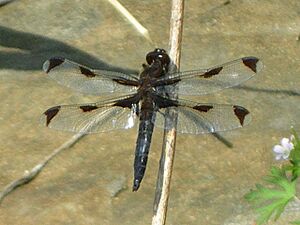Bekko Tombo facts for kids
Quick facts for kids Bekko Tombo |
|
|---|---|
 |
|
| Conservation status | |
| Scientific classification |
The Libellula angelina, also known as the bekko tombo, is a special type of dragonfly. It belongs to the Libellulidae family. These beautiful dragonflies are found in China and Japan. Sadly, they are in big trouble because their homes are disappearing fast. Because of this, the IUCN (International Union for Conservation of Nature) has listed them as critically endangered. This means they are very close to disappearing forever.
Contents
Meet the Bekko Tombo Dragonfly!
The bekko tombo is a golden or rusty-brown dragonfly. It has a dark stripe running down the middle of its body. Its wings have a unique pattern of dark markings. Like other dragonflies in its family, the bekko tombo has a body that is shorter than its wingspan. It also has a relatively short and wide abdomen.
Where Do Bekko Tombo Live?
You can find the bekko tombo in central and northern China. They also live in Japan, including the islands of Honshu, Shikoku, Kyushu, and other smaller islands. They are also found in Korea.
These dragonflies like to live in old and stable ponds. These ponds usually have a good amount of plants growing around them. They prefer lowland hill areas. The young dragonflies, called nymphs, need clear, open water. They crawl around in the mud at the bottom of these ponds.
Life Cycle of the Bekko Tombo
The bekko tombo is a univoltine species. This means it only has one generation born each year. Their young stage, called the larval period, lasts for one year.
The eggs of the bekko tombo hatch between May and June. The adult dragonflies then emerge the following spring. Male bekko tombo often compete fiercely to find and mate with females. After mating, the females usually start laying their eggs in the water right away. Often, the male will stay nearby to guard her while she lays the eggs.
Why Are Bekko Tombo in Danger?
The number of bekko tombo dragonflies has dropped a lot in recent years. The main reason is that their breeding habitats are disappearing. These are the old, stable ponds with plants around them that they need to lay eggs and for their young to grow.
Other problems include new predators. For example, the largemouth bass (Micropterus salmoides) has been introduced to some areas. These fish can eat the young dragonflies.
Since 1993, the bekko tombo has been a protected species in Japan. Many NGOs (non-governmental organizations) are working hard to help. They are trying to save the existing ponds and even create new suitable homes for these dragonflies. It is estimated that there are fewer than 5,000 bekko tombo left. This is why the IUCN has listed them as critically endangered.


